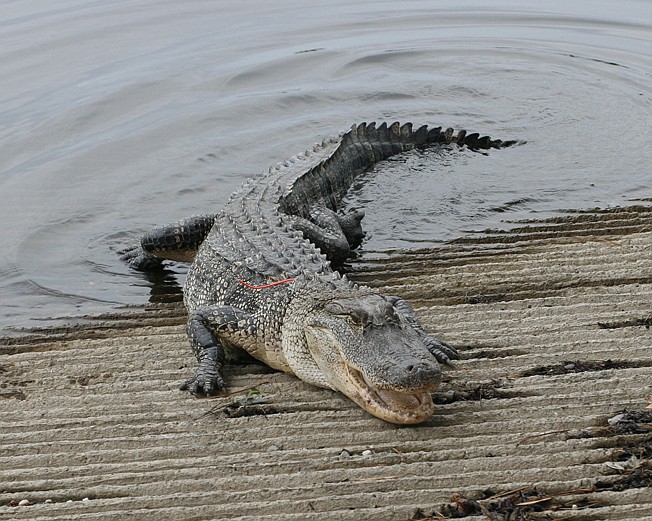Alligators are in their element, submerged in a deep river or lake with only their long snout visible to the human eye.
They can also often be found stretched out several feet on a riverbank, their scales soaking up the sun.
But sometimes, especially in spring, alligators go farther from their natural habitat and end up in town.
"This is their moving around time. We call it the 'springtime shuffle.' It's their breeding season and they are looking to pair up," said Eley Talley, a wildlife biologist with Arkansas Game and Fish Commission.
Earlier this month, wildlife officers relocated an alligator found in a pasture on Blackman Ferry Road in Miller County.
Around that same time, one was spotted on a residential street in Ashdown, Ark. Another was seen crossing a highway in Sevier County.
"They can really pop up anywhere. They are not afraid to move," Talley said.
All of the rain and flooding this spring could also be a reason alligators have been on the move. But spring is always the most active time for wildlife, Talley said.
"We get calls about alligators some in the spring. They are part of our ecosystem here," said Miller County Sheriff Jackie Runyon. "You have to get somebody out there with a pole and get it contained and relocated."
Talley said biologists with AGFC will relocate an alligator found in a heavily populated area.
"If it needs to be moved, we can catch and it and release it where it can be free to be an alligator. It makes country living fun," he laughed.
Locally, there is a good population of alligators on the Sulphur River, Talley said.
There are also some on the Red River and the Little River and Millwood Lake has quite a large alligator population.
Talley once relocated one found in a pond at Little River Country Club near Horatio, Ark.
Southwest Arkansas is the extreme northern edge of the alligator range. Dierks, Ark., is the farthest north Talley has ever seen one.
Alligators in Arkansas are American alligators that have been in the state for thousands of years, according to AGFC.
With the arrival of settlers the land was cleared and drained and the alligator was hunted without restriction.
By the early 1960s the loss of habitat and unregulated hunting had reduced the alligator population to the point where it was endangered throughout its range in the Southeast.
However, state and federal protection of the animal for over 20 years and restocking efforts have allowed alligator populations to recover. As a part of this recovery the AGFC restocked 2800 alligators in the 70s and 80s.
The alligator is still protected by state and federal laws, and it is illegal to feed, possess, harass, or kill an alligator unless it is during the hunting season. Modern day alligator hunting began in 2007 after approval from the U.S. Fish and Wildlife Service. Prospective hunters in both Arkansas and Texas must have a special permit and a general hunting license.
The average adult alligator ranges from 6 to 12 feet in length. Males grow bigger than females, with females rarely growing over 9 feet in length. Alligators are sexually mature when they reach 6 feet in length, according to AGFC.
Breeding takes place in May and June and eggs laid in late June or early July.
Females scrape and push decaying vegetation into a "nest mound" up to 3 feet high and 7 feet long. The heat generated from the decomposing plant material aids in the incubation of the eggs. The female lays 30 to 50 eggs in the nest mound and the eggs hatch in approximately 65 days. The female stays near the nest during this time to guard it from predators like raccoons and skunks.
Young alligators are mainly black and marked with yellow crossbars. This helps camouflage them from potential predators. The young will stay close together in dense vegetation for the first year and the female remains close by to protect them from predators.
Alligators survive cold winter temperatures by remaining submerged in deep water and coming up to breath only once every hour or so, or by retreating into dens dug in the banks of rivers or levees.
Alligators have to live in at least 67 degree water to grow and thrive. They can live in cooler water but they don't grow as much, Talley said. AGFC research shows a 10 foot alligator can live to be 25 to 30 years old, he said.
Alligators are related to crocodiles but there are obvious differences. Alligators have wider, U-shaped snouts, while crocodile front ends are more pointed and V-shaped. Crocodiles also tend to live in saltwater habitats, while alligators make their homes in freshwater marshes and lakes, like the ones in Southwest Arkansas, Texas and Louisiana.
These places can be safe for people and alligators if the people respect some common sense rules, Talley said.
Alligators are naturally wary of humans and if not accustomed to people, will retreat from their approach. However, alligators that have been fed will learn to approach humans looking for a handout, and this creates a serious problem for unsuspecting humans and their pets.
"You should never encourage them to be around people. If you are on a lake or river, don't throw out fish scraps where they can get an easy meal," Talley said. Also, do not leave food scraps on or near boat ramps, this is just the same as intentional feeding.
Other tips for people to coexist with alligators
n Do keep your distance to observe alligators.
n Don't swim or wade in areas where they are.
n Don't allow children or pets to go in or near water in a known alligator habitat.
n If an alligator is seen on a city street or a heavily populated neighborhood, residents should notify their local sheriff's office or AGFC.
Talley has respect for the unique, scaled creatures.
"They can survive a lot," he said. "We see them with scars and missing limbs sometimes. I've been playing with them for about 22 years and they are pretty cool," he said. "Alligators and alligator snapping turtles are as close to prehistoric animals as we have now."


